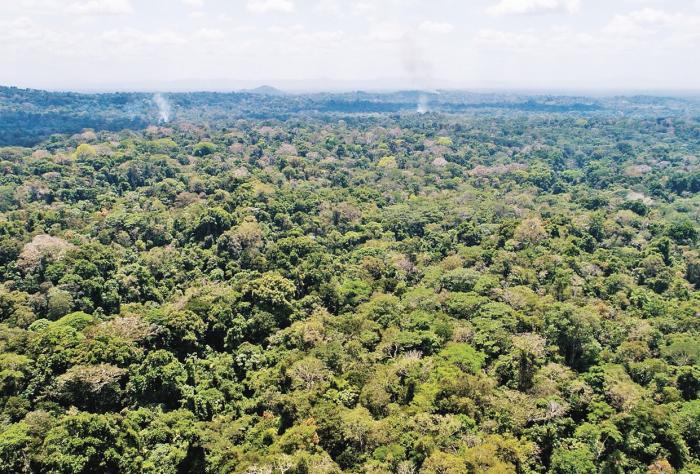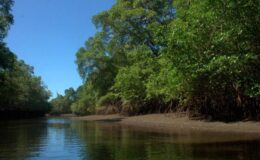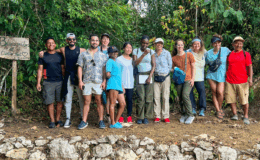Panamanian forests attaining allies for conversation
- By : James Bryson
- Category : Agriculture, Conservation

Planting trees is a way of giving life in all its forms, since they have the ability to reduce greenhouse gases through two processes related to the carbon cycle, the fixation or capture of carbon dioxide (CO2) from the atmosphere. and the reduction of emissions due to deforestation and forest degradation.
This process in which forests sequester carbon from the atmosphere contributes to climate change mitigation, experts say. A growing forest is classified as a carbon sink. In addition, trees produce oxygen, purify the air, form fertile soils, prevent erosion, keep rivers clean, capture water for aquifers, serve as refuges for fauna, reduce soil temperature, encourage the establishment of other species, regenerate soil nutrients and improve the landscape.
In the midst of the current situation the planet is going through due to climate change and global warming, what is being done in Panama to conserve forests? How many types of forests are there in the country?
Vaneska Bethancourt, head of cooperation and forest financing at the Ministry of the Environment (MiAmbiente), recognized that forests are key to the health of the planet and the well-being of human beings. In turn, he explained that more than half of the world’s economic production (that is, the gross domestic product (GDP)) depends on ecosystem services, and that includes the services provided by forests. Likewise, he emphasized that more than Half of the world’s entire population uses non-timber forest products to improve their well-being and livelihoods.

“The sustainable use of forests will help us move towards a green economy based on renewable, reusable and recyclable materials, low in greenhouse gas emissions,” Bethancourt explained.
HEAD OF FOREST COOPERATION AND FINANCING AT MIAMBIENTE
According to the latest 2021 forest cover and land use map presented by MiAmbiente, in Panama there are a total of 5,945,470 hectares of forests and other wooded land. This map was compared with the same methodology used for the report ‘Diagnosis of cover of forests and other wooded land of January 2020’.
According to this map, the country has a forest cover of 68%, which indicates that there was an increase of 3% compared to the year 2019, this result places the isthmus in a privileged position in terms of existing forests in the region. .
The good news is that deforestation events in the country have had a downward trend since 2000, remaining stable until 2012. However, in 2021 a significant decrease from 11,415 hectares (ha) to only 3,013 was observed. 86 ha, which reflects a reduction in deforestation, which indicates the importance of having technology as a control system, traceability and forest monitoring at the national level.
Another of the benefits or contributions that trees provide is that they increase soil fertility, because the amount of organic matter increases. Thanks to its roots, it reduces the erosion generated by water and wind, retaining the earth and avoiding, for example, landslides. With respect to water, they play a fundamental role as they improve its infiltration and retention, allowing it to reach underground aquifers.
Panama, an example for the world
Milciades Concepción, Minister of the Environment, was emphatic in pointing out that the forest cover recovery data shown today by the Ministry of the Environment are the result, to a large extent, of the concrete actions that have been taken in the current administration, such as the application of the resolutions that provisionally suspend the granting of special permits for subsistence forest exploitation and its modalities; as well as community permits and concessions in tropical forests for a term of no more than one year, in the same way the strengthening of laws that protect the environmental assets of the country.
This is coupled with the creation of a Superior Environmental Prosecutor’s Office, the Investigation Unit on environmental crimes of the National Police that houses the Ministry of the Environment and the implementation of the National Forest Restoration Plan.
“We are an example to the world. We managed to protect 30% of our seas, we are a carbon negative country and we have the largest forest cover in the region,” Concepción said in a statement.
Diana Laguna, Vice Minister of the Environment and head of the team of geographers that prepared the ministry for the mapping, indicated during her presentation that the regions that have lost the most forests in the last nine years are Panama, the Ngäbe Buglé region and Darién, while those that contribute the most are Darién, Veraguas and Panama.
As a positive impact, the official highlighted that at this same time the Azuero peninsula (Herrera and Los Santos), together with Chiriquí and Veraguas, are the ones that have gained the most forests.
On the other hand, he indicated that 43% of the forests are under protection as they belong to the National System of Protected Areas (Sinap).
Another fact that he emphasized was the value of stubble cover, which constitutes 6.46% of the country’s total forest cover, as it is an important contribution to the capture of greenhouse gases.
Regarding the districts, he indicated that 32% of the country’s forests are within the district areas, which demonstrates the high value that indigenous peoples have in conservation issues.
Regarding the hydrographic basins, according to the map, the one with the highest percentage of forests is the Chucunaque River with 8.85%, the Bayano River with 7.05%, the Tuira River with 5.79%, the Changuinola River with 5.42%, and the Cricamola river basin and between Cricamola and Calovébora with 4.40%.
With respect to Central America and the Dominican Republic, countries that make up the Central American Integration System (SICA), Panama has the largest forest cover, which according to Laguna reaffirms once again the country’s status as one of the three nations globally to be Negative carbon, that is to say that the Panamanian territory captures more carbon dioxide than it generates.
The implementation of the National Forest Restoration Program has had a significant impact on the forests of Panama due to the forest restoration approach that is evident in the recovery of degraded lands and conservation of stubble that has become young forests, sequestering greenhouse gases. .
Types of forests in Panama
According to the 2021 map classifications, there are between 9 and 10 types of forests in the country, and thanks to the implementation of the National Forest Restoration Program, a significant impact has been achieved on the forests of Panama due to the forest restoration approach that is evidence in the recovery of degraded lands and conservation of stubble that has become young forests, sequestering greenhouse gases. First is the mature mixed broadleaf forest, which is composed mainly of adult trees with tall diameters and large crowns. With less presence of understory and with a presence in the area for more than 40 years, although selective felling has been practiced.
Secondary mixed broadleaf forest follows. This is characterized by a greater presence of pioneer species. These are trees with medium or low diameters and their crowns are not large. The difference between a stubble and a secondary forest is that its average height is greater than five meters and the coverage of its crowns is greater than 30%. Secondary forests are considered to be stubble with a height of less than five meters that have been declared for forestry purposes.
Then there is the mangrove forest, these are forest formations in which 60% of the trees present (number of trees per hectare) belong to one or more mangrove species.
Not far away is the orey forest, they are forests that are made up of 60% by the species of Camprosperma panamensis (orey).
The cativo forest, which is made up of 60% of predominant trees of the Prioria copaifera (cativo) species.
There is also the raffia forest, a natural forest that is made up of 60% of the species Raphia taedigera (raffia).
While the planted coniferous forest is one of the predominant species, among them are pines, firs, cypresses, and araucarias.
The planted broadleaf forest is predominantly composed of angiosperm species, that is, broad-leaved trees.
And the stubble and shrubby vegetation is made up of different tree and herbaceous species that appear naturally after the abandonment of land under agricultural use whose average height is less than five meters.
The wood from each of these trees can be used for a variety of purposes, with less environmental impact than many alternative materials. Once wood is used, it can be reused and recycled, extending its useful life and further reducing its material footprint.
“Science and innovation are generating exciting new products from wood and trees, including textiles, food, construction materials, cosmetics, biochemicals, bioplastics, and medicines. Replacing less sustainable materials with renewable wood and tree-derived products can reduce the carbon footprint,” said the technician.
How forest fires influence
Forests and environmental challenges
In Panama, for example, in recent days a fire was reported in the Alto Guarumo Forest Reserve in the province of Veraguas. This fire was attended by park rangers, firefighters and community personnel. On Friday, April 7, 16 affected hectares were recorded; however, the strong winds affected the extinction efforts, prolonging the actions until the following day, when the incident covered more than 50 hectares.
Julieta Fernández, regional director of Veraguas, said that the fire against fire strategy was used to reduce plant mass fires, they also keep cleaning the access roads in order to avoid damage to the plantations. MiAmbiente will take the coordinates to determine the level of affectation and a report will be raised. Fernández stressed that there are indications that the possible reason for the plant mass fire in Alto Guarumo was as a result of a slash and burn practice, adding that there was no permit for this.
Jorge Escudé, in charge of the Environmental Culture section, said that plant mass fires are an important source of carbon emissions that contribute to global warming and also have repercussions on biological diversity and human health.
He added that the cause of global warming is the increase in the natural greenhouse effect due to the increase in the concentration in the atmosphere of greenhouse gases produced by human activities.
At the same time, he mentioned that in Panama in the last decade (2012-2022) 16,099.0 plant mass fires have been registered, affecting a total area of 229,528.69 hectares, which includes intervened primary forest vegetation, secondary forest, stubble, mangrove forest, planted forests, floodplain vegetation, grasses, established agricultural crops and pastures.
Regarding controlled burning permits, he pointed out that only the Ministry of the Environment is the competent authority to issue or grant these permits, through Law 1 of February 3, 1994, the Forestry Law, which establishes the control measures for burning. and the conditions for the granting of permits for sugarcane harvesting and burning for agricultural production, not exceeding five hectares and requirements for burning greater than five hectares.



No Comments